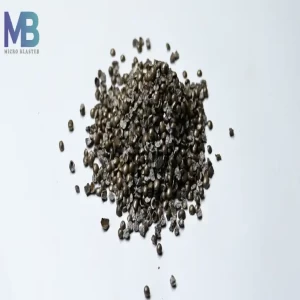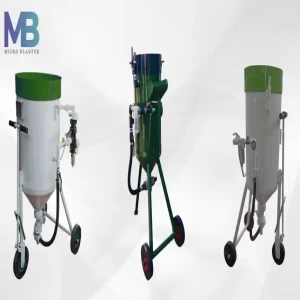Search

Remote Control Valve
The remote control valve is a totally pneumatic air control or command that allows you to activate and deactivate the abrasive material remotely. The remote control valve is utilized by the abrasive media blasting operator to start and stop the portable sand blasting machine.

Product Details:
| Product | Remote Control Valve |
| Material | Aluminium |
| Size | 1x1/4 inch |
| Weight | 2.5 KG |
| Color | Black/Silver |
| Country | India |
| Brand | Micro Blaster |
| Delivery Time | 7-10 Days |
| Packaging Details | Polly Pack With Bubble Packing |
| Transport Type | Land/Sea/Air Transport |
Introduction Of Remote Control Valve
A remote control valve is a valve that regulates discharge of abrasive media in a sand blasting machine. Sand blasting is technique of cleaning & preparing externals by aggressively forcing an abrasive substance against them. Remote control valve enables operative to regulate discharge of abrasive media from a secure space, eliminating need to physically manipulate valve at sand blasting nozzle. A remote control valve has two valves in one body: bottom for compressed air entry & upper for managing an abrasive blasting machine exhaust output.
Remote Control Valve For Sand Blasting
All abrasive blasting machines must be equipped accompanied by remote controls certain are designed to turn off equipment as fast as feasible. A mechanism for activating remote control valve for sand blasting must be situated at nozzle & used in conjunction chaperoned by blasting. Employing blast machines without remote controls is a risky & undesirable practice that might result in significant injury to blasters & other persons in area.
In addition to apparent safety features, there are other benefits to utilizing, remote controls. Immediate start & stop response delivered by remote control systems bypasses substantial waste of abrasive. If a nozzle needs to be pointed in air while remaining for an individual else to shut off machine & while the blasting is transferring on structure, suitable abrasive media is existing squandered. Another labor-saving advantage is eliminating an essentials of a helper who tends blast machine.
A continuous origin of compressed air is delivered to inlet RCV on deadman handle throughout a 1/4" i.d flexible air hose from fitting on lower part of the body. Air supply is yielded from outlet on deadman handle to fitting on upper part of body by a second 1/4" i.d. air hose
Activation of the two valves is achieved simultaneously by closing deadman handle. Deactivation takes place immediately on release of handle & by extending safety petcock on valve body. It is a characteristic of this system certain air revitalized from an abrasive blasting machine doesn't pass throughout working elements of a valve, thus any wear caused by airborne bits of abrasive is specified to rubber diaphragm.
The Blasting (on) Action
When deadman handle is turned, twin-line control hose's circuit closes. Pressured enclosure intimidations top & lower valves to drive out from one additional.
In this exhibition, supply air moves through bottom valve & flows to a portable sand blasting machine & nozzle. Top valve shuts blowoff connection through diaphragm.
The Shut Down (off) Action
When deadman handle is removed, pressurized hose is linked to atmosphere through regulation in association with deadman handle. At the same time sand blasting hose is unrestrictedly & associated with atmosphere throughout deadman handle. In this condition, an upper valve is propelled down by blow-off pressure so certain pressure inside the sand blasting machine could escape throughout a port into bleed-off various chambers & then throughout the silencer to the atmosphere. The supply airflow (from port 3 to port 2) causes the more inferior valve to move upwards & close tightly against valve housing.
Activation of the two valves is achieved simultaneously on closing deadman handle. Deactivation takes place immediately on release of the handle or by extending the safety petcock on valve body. It is a feature of this system that air exhausted from abrasive blast machine doesn't pass throughout the working elements of the valve, thus any wear caused by airborne bits of abrasive is specified to rubber diaphragm.
Type Of Remote Control Valve
RCV Remote Control Valve
RCV remote control valve controls both compressed air input to machine & air blow-out. Abrasive blasting machine user starts both control operations by encouraging & removing DMH handle. A damper combined into a delivery set is utilized to remove air from the tank.
DMH Remote Control Valve
DMH remote control handle is connected to sand blasting nozzle & attached to RCV remote control valve throughout a double hose.
Pushing DMH handle engages RCV remote control valve. Blast machine's tank is pressurized, & abrasive blasting approach begins. When DMH handle is removed, RCV remote control valve closes, an abrasive blast process is over, & the machine's tank depressurizes.
Remote Control Valve Operation
Manual remote control valve pressure dismissal pneumatic systems work on return-air conception, accompanied by a handle at sand blasting nozzle. This handle attaches pneumatically to sand blasting machine intake & outflow valves. By shutting safety petcock on intake valve & depressing handle, inlet valve opens & blasting starts, duration outlet valve closes. When you remove handle, process reverses, & blasting stops. This safety feature stops uncontrollable blasting. After blasting session, opening safeness petcock prevents unintentional activation, even chaperoned by handle depressed.
For tasks demanding frequent starts & stops, machines should possess pressure-hold pneumatic remote controls. These controls uphold machine pressure, authorizing operative to initiate & cease blasting while needed. Manual pressurization & depressurization are needed. Remote control handle independently manages abrasive & air on/off. Both pneumatic & electric models are available.
Remote control valve for sand blasting is utilized to regulate discharge of compressed air to blast pot & sand blasting hose. Pneumatic remote control system comprises of an intake & outlet valve, a deadman handle, & a twin line hose. When engaged deadman handle furnishes air reserve, input valve opens immediately, exit valve closes, an abrasive blasting machine is pressured, & blasting action begins. Deadman handle is released, whichever causes machine to depressurize & pop-up valve loading port to open. An extra supply of abrasive media in the recessed head & storage hopper then refill the machine. Instant start/stop of a remote control blast machine will affect 20-40% abrasive savings, 50% labour removal, ensure the greatest site safety & a comprehensive boost in rate of production.
Remote Control Valve Features
- Differential Pressure Control: Provides exact management and control of your blasting operations.
- Comprehensive Service Kit: Includes a full set of alternate components such as seals, gaskets, o-rings, & more, assuring long-term use & easy maintenance.
- Durable Construction: Engineered to endure the severities of industrial use, assuring dependability & a longer service life.
Remote Control Valve Supplier
Micro Blaster is the leading manufacturer of remote control pneumatic valves and also a remote control valve supplier all over the world. In comparison to others, our remote control valve price is low. We also offer all types of sand blasting machines, sand blasting hpper, portable sand blasting machines, sand blasting nozzles, sand blasting spare parts, pinch valves, thermal spray booths, thermal spray masking tape, dust collectors, air compressors, metalizing wire, and more.

